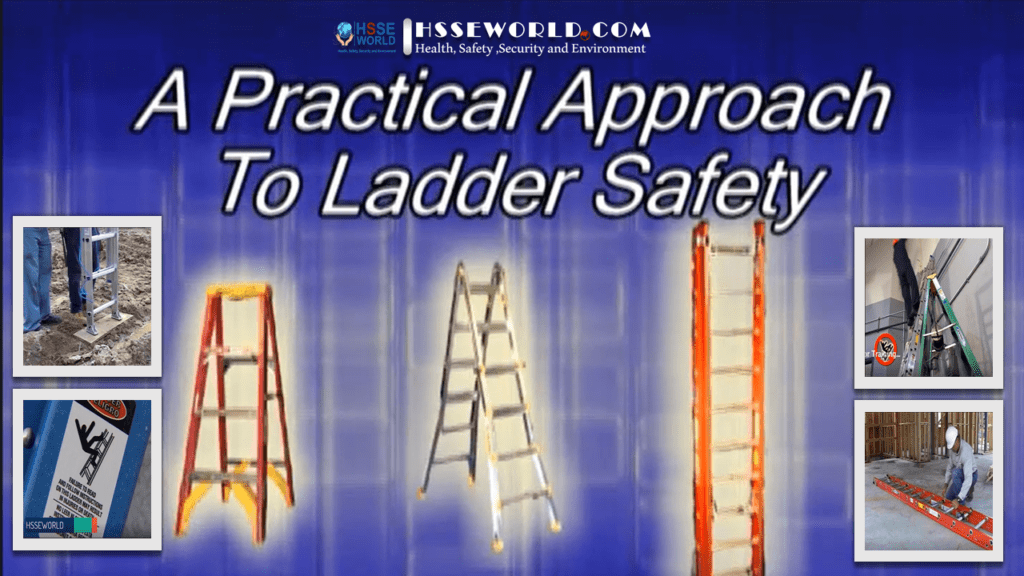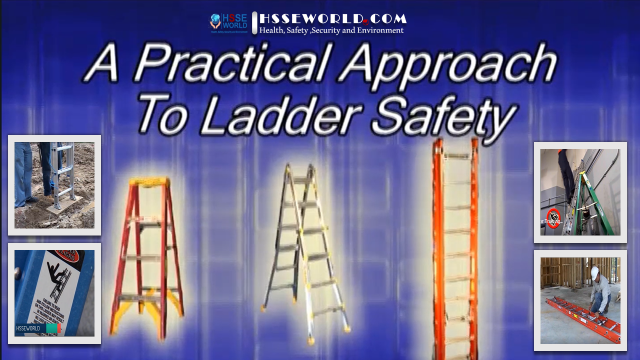While ladder manufacturers strive to produce the safest ladders possible, a well-made ladder is not enough. This video discusses the basic Ladder safety precautions that will keep employees safe when using ladders. Viewers will also see the consequences of failing to follow these safe work practices.
- How to correctly choose a ladder according to type, construction and duty-rating.
- What to look for when inspecting a ladder before use.
- How to properly place and set step and straight ladders.
- How to stand and work on a ladder properly.
- Why ladders shouldn’t be intentionally misused.
- What unique hazards are posed by multi-function ladders.
( for more learning watch the Video Below )

Background
Ladders are used to reach elevated areas in just about every type of job, industry, and at home. while there are many types of ladders and countless jobs performed with these valuable tools, the basic safety rules are similar for all ladders.
Most of us are aware of these rules; yet, we often choose to ignore them, often taking our safety for granted when using ladders. Unfortunately, this nonchalant attitude leads to 300 deaths and 165,000 injuries each year.
Ladder manufacturers strive to produce the fastest ladders possible, but a well-made ladder is not enough. Our safety while on a ladder depends on following safe work practices: first, choose the correct ladder for the job; secondly, inspect the ladder before use; third, set up the ladder properly; and, finally, use the ladder in a safe and proper manner.
Photo of the day: Ladder Safety Tips
Selecting the Correct Ladder
Before doing anything with the ladder, make sure you have selected the correct ladder for the job. The two most common types of ladders are the step ladder and the straight ladder. A straight ladder can be a single ladder or an extension ladder that can be adjusted for additional height.
Another type of ladder, the multi-functional ladder, is common in man facilities because of their portability and versatility, these ladders can perform a variety of tasks.
Ladders are constructed in a variety of materials, including wood aluminum, and fiberglass, which is the most commonly used.
Because aluminum ladders are conduct electricity, they should never be used while performing electrical work or where they may come in contact with live electrical parts.
Wooden Ladders may contain hard-to-spot weaknesses and defects, especially if the ladder has been painted. This is why you should never paint a wooden ladder and always inspect them thoroughly before use.
When selecting a ladder, make sure the ladder is long enough to reach the height you need and allows you to work comfortably. Many injuries and deaths occur when people try to work from a ladder that’s too short.
Make sure the ladder is sturdy and strong enough to support the working load. the working load is the combined weight of your body and the work materials to be used while on the ladder.
Portable Ladder Self Inspection checklist
Many people are unfamiliar with a ladder’s duty rating. This rating can be found on the ladder and indicates the working load it can safely support.
A type I-AA special-duty ladder can hold up to 375 pounds. A type I-A rating means the ladder can hold up to 300 pounds. A type I rated ladder holds up to 250 pounds. Ladders with a type 2 rating will only hold up to 225 pounds. Ladders with a type 3 rating hold just 200 pounds and are not recommended for industrial or commercial applications.
Keep in mind that many job tasks require the use of scaffolds or aerial work platforms, rather than ladders, to perform them safely. Jobs that entail side-to-side movement or the use of heavy or awkward tools should not be performed on a ladder.
If you have any questions about the appropriate equipment for your job, ask your supervisor. ( Portable Ladder Safety )
Watch the video below to know more about:
- Inspecting the ladder before use
- Transporting your ladder
- Placing he ladder
- Setting up the ladder on uneven/unstable surfaces
- Placing the ladder around round objects
- Other stability factors
- Setting up straight ladder
- Preparing to climp and climping the ladder
- Standing and working on ladder safely
- Descinding and putting up the ladder
- Multifunctional ladders
- International Missuse of ladders
- Platform ladders
Watch The Video :
More videoes
- Creating safety in welding operations
- Video: Ladder Safety-A Practical Approach
- Video: Stored Energy
- Video: Hydrogen Sulfide Employee Training
- Video: Protecting our sight
- Video: Supported Scaffolding Safety
- Preventing Fires During Hot Work Operations
- Video: Lockout – Tagout Safety Training
- Video: Preventing Heat-Related Illnesses
- Video: Your Personal Fall Arrest System: Surviving the Fall
- Accident Investigation for Everyone
- Video: Fire Prevention & Response
- RCRA Hazardous Waste Final Rule: The E-Manifest System & Other Key Revisions
- Video: Avoiding line of Fire: Safety Moment#36
- Video: Employee safety in confined spaces
- Video: Aerial Work Platform Safety: Safety Moment#35
- Tips to Avoid Standstill Accidents: Safety Moment#33
- Common Causes of the workplace incident: Safety Moment#32
- Evaluating the Effectiveness of Leading Indicators and Developing High-Impact for safety
- Machinery Guarding: Safety Moment#31
- Electrical Safety While Working From Home: Safety Moment#30
- Dehydration in cold weather
- Lifting Calc 3: Safety APP
- Video: Working safely Near powerlines -Safety Moment#26
- Video: Winter’s Hidden Hazard -Safety Moment#25
- Video: Isocyanates Exposure -Safety Moment#24
- Video: Electrical Safety Awareness -Safety Moment#23
- Safety Flash: Laborer Dies After Footing Collapse – North Carolina
- Risk Assessment Training and Application tool
- Falls from heights :Video-Safety Moment #14
- The Golden safety rules :Video-Safety Moment #12
- Incident Report Form
- Video:Accident Investigation-1
- Slips,Trips and Falls checklist
- scaffold-Power fatility
- Nitrogen Hazard lead to Fatal Accident
Download More safety Resources at Safetybagresources.com





